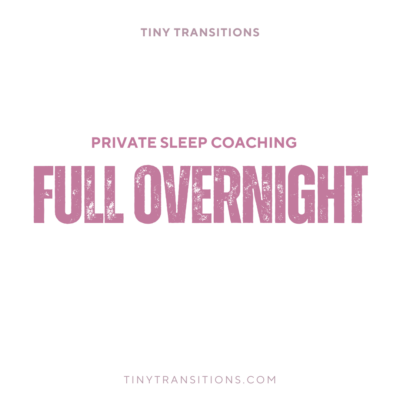The Ferber sleep method – or Ferberization – falls under the umbrella of Cry It Out (CIO) sleep training. On one end of the Cry It Out spectrum is unmodified extinction, known for being more rigid. On the other end is the gentler Ferber method, sometimes referred to as graduated extinction.
With the Ferber method, parents let their babies learn how to put themselves to sleep, but parents can intervene to some degree. The Ferber sleep method’s goal is to retrain a baby to fall asleep without their parents’ help. It asserts that with consistent training, babies forget their old sleep crutches (nursing, rocking, etc.), and eventually learn new self-soothing methods that enable them to fall asleep on their own.
Who Developed Ferber Sleep Training?
Dr. Richard Ferber wrote a book in 1985 called “Solve Your Child’s Sleep Problems,” which is where today’s Ferberization trend started. Though some aspects of graduated extinction existed before this time, he defined it and gave examples and advice that people could successfully follow.
How are the Ferber Sleep Method and the Unmodified Extinction Method Different?
The Ferber sleep method and the unmodified extinction method (CIO method) are the most talked-about sleep training methods currently. While they share several similarities, there are also key differences that make the Ferber method appealing to many parents.
Parental Involvement
The main difference between the two methods is that there is quite a bit of parental involvement with the Ferber Sleep Method. Whereas the unmodified extinction method suggests parents resist helping their babies when they are fussy at night, the Ferber Sleep Method encourages it – with some restrictions.
The Ferber Sleep Method lets parents enter their baby’s room at set intervals, but the parents aren’t necessarily supposed to have physical interaction with their babies. Some sleep trainers condone back pats, shushing, and belly rubs to help calm the baby, but most agree that parents should avoid picking up their baby at all costs. Picking up the baby all the way can “reset the clock,” making it extra difficult for the baby to self-soothe.
The primary purpose of the parental interaction is to reassure the baby that the parent is nearby, which can have a calming effect. Critics of the Cry It Out method believe that letting a baby cry without any attempts at parental interaction can have damaging psychological and emotional effects on the baby, but these claims lack sufficient scientific research to make them valid.
Parental Attitudes
Because parents are allowed to go in and help soothe their babies in the Ferber sleep method, there are generally more positive attitudes toward that method of sleep training. Letting a baby cry unrestrained is hard on most parents, and using the unmodified extinction method of sleep training can be emotionally taxing on parents.
With the Ferber sleep method, however, parents are permitted to go into the child’s room at specific intervals to reassure and calm their baby. Even though these help sessions are brief (only one to two minutes long), they make the parents feel like they are doing something to ease their baby’s discomfort. That, in and of itself, can lift both the baby’s and the parents’ attitudes, making sleep training slightly less uncomfortable in the long run.
Cry Time
Another significant difference between the Ferber Method and the Cry It Out method is the type and duration of crying involved. For staunch Cry It Out method users, parents leave the baby until the next morning, hoping that the baby will learn how to self-soothe over time.
The Ferber sleep method is significantly different in this regard. Instead of letting the baby cry unassisted, parents enter the room and offer calming words or pats at pre-set intervals. The timer starts once the baby starts fussing, and it resets once the parent leaves the room and the child begins to get upset again. Each time the parent leaves the room, the interval between the next visit extends by a few minutes until a set maximum. Here is an example schedule:
| 1st Visit | 2nd Visit | 3rd Visit | 4th Visit | Additional Visits | |
| Day 1 | 2 minutes | 4 minutes | 8 minutes | 10 minutes | 10 minutes |
| Day 2 | 3 minutes | 5 minutes | 10 minutes | 12 minutes | 12 minutes |
| Day 3 | 5 minutes | 10 minutes | 12 minutes | 15 minutes | 15 minutes |
It’s important to note that using the Ferber method doesn’t mean that you let your baby cry day after day, week after week, until they learn how to sleep, by golly! In fact, in an interview with NPR in 2006, Dr. Ferber reminded listeners that he doesn’t encourage or advocate for babies to cry on their own for weeks on end. Holding fiercely to any sleep training method for too long can lead to babies becoming withdrawn and afraid of sleep – something parents definitely don’t want.
Instead, he stated that the Ferber method of sleep training is designed to help parents do away with poor sleep habits. Some examples of sleep habits that negatively impact sleep include rocking to sleep, nursing to sleep, or laying down next to a child to get her to go to sleep. He viewed using these sleep crutches as being dishonest with your child.
“A typical example of that is a child who is rocked to sleep, the family is sneaking them into the crib and then tip-toeing out of the room. So when they wake up at night, lo and behold everything has been changed. Now that child is not going to be very happy with that. If the family wants the youngster sleeping in the crib by themselves then they have to be honest with their youngster. And you put the child into the crib awake.”
Can you imagine going to sleep in one location and circumstance and waking up in another one, completely isolated from the people you fell asleep with? It would be startling, to say the least. So in Dr. Ferber’s eyes, not only are you teaching your child the new skill of falling asleep on her own, but you are also being upfront and honest in your sleep expectations with your child.
The upside of all of this is that children are wildly adaptable. By gradually replacing their current norm (needing to be rocked to sleep, etc.) with a new norm (going to sleep with minimal parental assistance), most parents yield impressive and long-lasting results reasonably quickly.
The Do’s and Don’ts of the Ferber Method
The Ferber sleep method is more gentle than Cry it Out, but that doesn’t make it more flexible. There are some right and wrong ways to approach Ferberization if you want to be successful.
DO manage your expectations
Every child is different in how they respond to sleep training, so there isn’t a one-size-fits-all answer for what to expect. That said, there are some expectations that you should check at the bedroom door.
- Things won’t change overnight. While most parents see significant improvements within just a few days, the change won’t be immediate. You need to expect things to be rough for a few nights (and the subsequent tired days), but things should also improve quickly.
- Everyone will be tired. As you are sleep training, there will be longer waking times and more fussiness – both at night and during the day. It won’t last forever, but you should be prepared for it. Have a plan in place to ensure that everyone gets in a good nap during the day so that they are ready for the night ahead. Additionally, you probably want to start on a weekend, since those first few nights are often the most difficult.
- You might have some set-backs. You may end up going through several rounds of sleep training. The timing might have been wrong when you started sleep training, or your baby might hit a sleep regression. Most kids have bouts of poor sleep, so you might end up sleep training multiple times.
DO be consistent
The most important factor in having a successful sleep training experience is to be consistent. With the Ferber method, that means that you set timers and resist the urge to go in and help your baby when she is whimpering.
DO keep the end in mind
When things get hard, remember that this won’t last forever. Your end goal with sleep training is to get everyone sleeping better. People who sleep well are happier, safer, and better thinkers all around, so it’s worth it to put in the time to get the result you want.
DON’T spend a lot of time consoling
It is tempting to go in and rock and cuddle and coo your baby back into a happy state, but it’s best to resist the urge. Your main goal is to enter the room, remind your baby that you are nearby, and leave again to give your baby a chance to self-soothe. It’s ok to pat your baby’s tummy or booty for a minute or two, but don’t do a lot of shushing, and don’t pick your baby up if you can help it. That can set back all of the work you had put in until that point.
DON’T think it’ll be a piece of cake
Listening to your baby cry is never easy, and there will likely be quite a bit of protest while you are sleep training. That said, there are some things that you can do to make it a little easier on yourself and your baby. Start with a soothing, consistent bedtime routine. Have a warm bath, a snack, brush teeth, use favorite PJs, read stories, sing songs, and give lots of cuddles before bed to put everyone in a happy mood. You should also keep the room dark and use a noise machine if that helps your child stay calm.
When your baby starts protesting after you leave, have a plan to keep yourself distracted. Some ways you can stay sane during the interval periods include:
- Going to another room during the interval periods instead of listening outside the door
- Read a book or do another favorite activity with headphones in
- Have a support system nearby (either physically or over the phone) to help you stay calm and collected
- Take deep, calming breaths during the interval periods
Once you get your baby’s sleep habits under control, it’s still likely that she will experience some regressions at some point. Luckily, there are some solutions that help manage sleep regressions.
The Ferber sleep method is a great thing to try if you want quick results with less crying. It allows parents to interact with their babies, which provides assurance during an otherwise difficult time. The key points are maintaining a consistent routine, procedure, and mindset to get everyone sleeping better.










